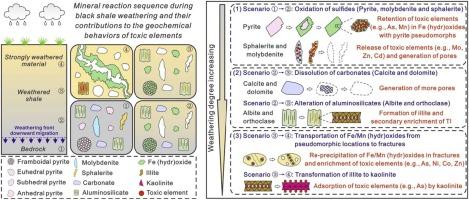黑色页岩风化过程中有毒元素的矿物依赖性释放、迁移和富集:剖面尺度到矿物尺度的综合研究
IF 11.3
1区 环境科学与生态学
Q1 ENGINEERING, ENVIRONMENTAL
引用次数: 0
摘要
具有高地球化学背景的岩性(如黑色页岩)的化学风化作用被认为是土壤和水系统中有毒元素的重要来源。然而,对黑色页岩风化过程中有毒元素释放、迁移和富集的控制机制尚不清楚。本研究利用TESCAN集成矿物分析仪(TIMA)、扫描电子显微镜-能量色散x射线能谱(SEM-EDS)、x射线光电子能谱(XPS)和电子探针分析(EMPA)等一系列微观分析技术,阐明了从剖面尺度到矿物尺度的矿物转化与元素行为之间的密切关系。黑色页岩风化剖面(和表面强风化物质)的矿物学和元素组成表明,主要的矿物反应顺序为硫化物氧化、碳酸盐溶解、铝硅酸盐蚀变和粘土矿物转化。有毒元素主要从风化剖面中释放出来,在强风化物质中富集。黑色页岩风化是由黄铁矿、闪锌矿和辉钼矿氧化引发的,这些化学反应主要释放As、Cd、Mo、Mn、Ni和Zn等有毒元素。在黄铁矿氧化过程中,铁(水合)氧化物以假晶形式取代了黄铁矿颗粒,同时释放出As和Mn,并将其保留在铁(水合)氧化物中。硫化物氧化产生的硫酸首先溶解周围的方解石和白云石,显著改善风化页岩的孔隙-裂缝网络,增加了水通量和铁(氢)氧化物的输送,并伴随有毒元素的迁移。然后,钠长石和少量正长石蚀变为伊利石,在整个风化剖面中对Tl进行了二次富集。在强烈风化阶段,Fe/Mn(氢)氧化物大量被输送到裂缝中再沉淀,导致As、Ni、Co、Zn、Cd等元素大量富集。同时,伊利石向高岭石的转变也可能影响有毒元素的富集。研究结果表明,了解黑色页岩风化过程中矿物转化对有毒元素释放、迁移和富集的控制作用,可为黑色页岩地区有毒元素风险预测和评价提供理论依据。本文章由计算机程序翻译,如有差异,请以英文原文为准。

Mineral-dependent release, migration and enrichment of toxic elements during black shale weathering: An integrated study from profile scale to mineral scale
Chemical weathering of lithologies with high geochemical backgrounds such as black shale has been proposed to be a critical source for toxic elements in soil and water systems. However, mechanisms controlling the release, migration and enrichment of toxic elements during black shale weathering are poorly understood. This study utilized a suite of micro analytical techniques such as TESCAN integrated mineral analyzer (TIMA), scanning electron microscopy–energy dispersive X-ray spectroscopy (SEM–EDS), X-ray photoelectron spectroscopy (XPS) and electron micro-probe analysis (EMPA) to elucidate the intimate relationship between mineralogical transformations and elemental behaviors from profile scale to mineral scale. Mineralogical and elemental compositions for a black shale weathering profile (and surface strongly weathered materials) suggest a dominant sequence of mineral reactions as oxidation of sulfides, dissolution of carbonates, alteration of aluminosilicates, and transformation of clay minerals. Most of the toxic elements were largely released from the weathering profile and significantly enriched in the strongly weathered materials. Black shale weathering was initiated by oxidation of pyrite, sphalerite and molybdenite, and these chemical reactions dominated the release of toxic elements (e.g., As, Cd, Mo, Mn, Ni and Zn). During oxidation of pyrite, Fe (hydr)oxides pseudomorphically replaced pyrite grains, along with the release of As and Mn and their subsequent retention in Fe (hydr)oxides. Sulfuric acid generated by oxidation of sulfides firstly dissolved surrounding calcite and dolomite to significantly improve the pore-fracture networks in the weathered shale, allowing more water fluxes and transportation of Fe (hydr)oxides and concomitant migration of associated toxic elements. Then, albite and minor orthoclase were altered to illite that was responsible for the secondary enrichment of Tl throughout the weathering profile. In intense weathering stage, Fe/Mn (hydr)oxides were substantially delivered to re-precipitate in fractures and contributed to considerable enrichment of As, Ni, Co, Zn and Cd. Meanwhile, transformation of illite to kaolinite may also influence the enrichment of toxic elements. This work highlights the importance of understanding the control of mineralogical transformation on release, migration and enrichment of toxic elements during black shale weathering, such that this mineral-dependent mechanism can be implemented to risk prediction and assessment of toxic elements in black shale regions.
求助全文
通过发布文献求助,成功后即可免费获取论文全文。
去求助
来源期刊

Journal of Hazardous Materials
工程技术-工程:环境
CiteScore
25.40
自引率
5.90%
发文量
3059
审稿时长
58 days
期刊介绍:
The Journal of Hazardous Materials serves as a global platform for promoting cutting-edge research in the field of Environmental Science and Engineering. Our publication features a wide range of articles, including full-length research papers, review articles, and perspectives, with the aim of enhancing our understanding of the dangers and risks associated with various materials concerning public health and the environment. It is important to note that the term "environmental contaminants" refers specifically to substances that pose hazardous effects through contamination, while excluding those that do not have such impacts on the environment or human health. Moreover, we emphasize the distinction between wastes and hazardous materials in order to provide further clarity on the scope of the journal. We have a keen interest in exploring specific compounds and microbial agents that have adverse effects on the environment.
 求助内容:
求助内容: 应助结果提醒方式:
应助结果提醒方式:


